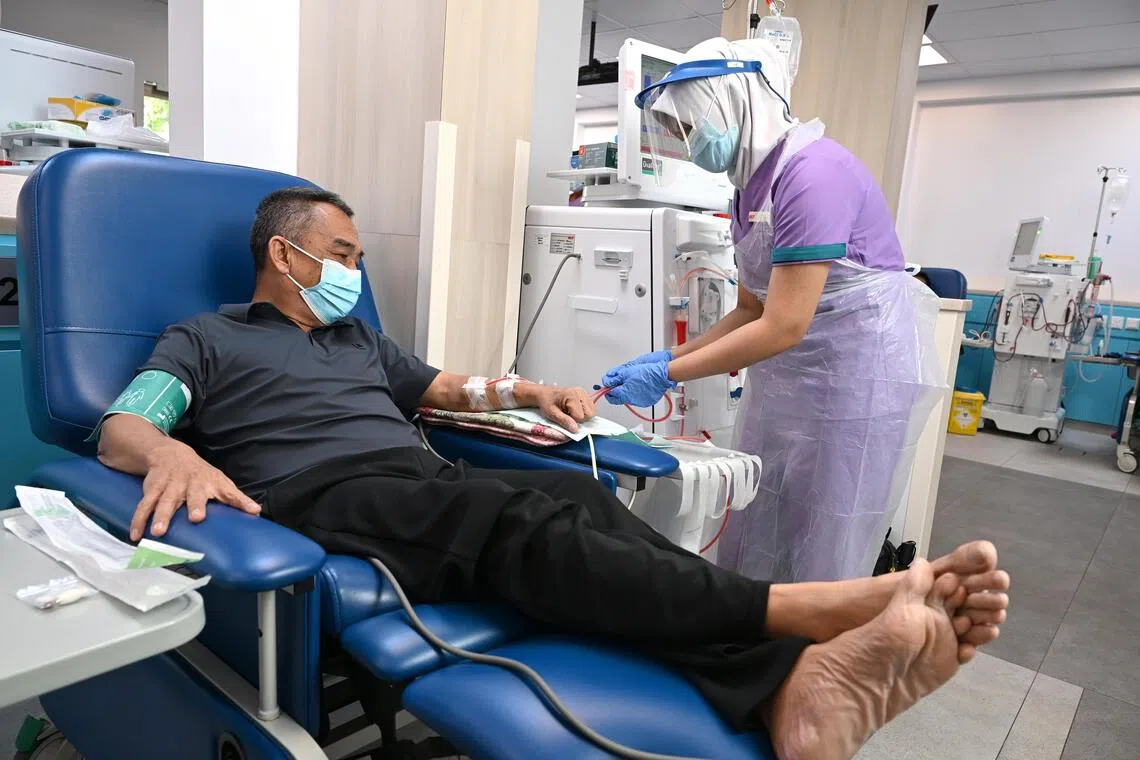How kidney dialysis takes a toll on one patient’s life and work
Sign up now: Get ST's newsletters delivered to your inbox

Mr Lim Chee Meng, 55, undergoing kidney dialysis at The National Kidney Foundation Aljunied Centre on Nov 1.
ST PHOTO: DESMOND WEE
Follow topic:
- Mr Lim Chee Meng, 55, undergoes painful thrice-weekly dialysis due to kidney failure from past unhealthy habits.
- Dialysis involves inserting large needles for blood cleaning, restricting fluid intake to 500ml, and causes fatigue, impacting work.
- Witnessing Mr Lim's suffering has motivated his 78-year-old mother, who has diabetes, to adopt a healthier lifestyle to avoid dialysis.
AI generated
SINGAPORE - Mr Lim Chee Meng, 55, dreads his thrice weekly kidney dialysis sessions at The National Kidney Foundation, but he has no choice as he suffers from kidney failure. He said: “Each time they insert two needles, it’s very painful. Each time, they have to use different spots.”
At every dialysis session, two needles are inserted in the area where an artery has been surgically connected to a vein, to strengthen both blood vessels.
One needle removes blood from his body and the other to return the blood that has been cleaned by the dialysis process. To allow for the blood to flow smoothly, the needles are 1.4mm to 2.1mm wide.
Had he known kidney failure involved so much suffering, the taxi driver said he would have taken better care of his health. Even after he was diagnosed with diabetes 10 years ago, he continued drinking at least two sweet sodas a day and did not exercise.
Now, he makes sure his mother, 78, who also has diabetes, changes her eating and exercise habits. “I really hope she will never need dialysis. It will be difficult for her at her age,” Mr Lim said. However, seeing her son suffer has motivated her to stick to a healthy lifestyle, he added.
Dialysis patients should not consume more than 500ml of liquid a day, including liquids from soups and gravies, as most are unable to urinate, so liquid consumed has to be cleared during dialysis. Mr Lim said he is always thirsty so sometimes, he drinks a bit more but his limbs and face swell up. He also has to avoid sodium as it raises his blood pressure and fluid build-up around the heart and lungs.
As dialysis is tiring, he works only from 4pm to 11pm. To make up for the loss of income, he cannot afford to take a day off. Regular dialysis also means no more long holidays.
Dialysis also takes its toll on caregivers. Mr Peter Koh, whose wife Gan Gok Chuan has been a dialysis patient for 14 years, said: “It wears on your body, your mind and your heart. It is not just the patient who struggles – the whole family carries it.”
The harsh realities of undergoing kidney dialysis
Kidney dialysis helps to keep you alive but will profoundly impact your daily life.
Most patients can drink only 500ml to 1,000ml of water a day, including liquid from soup and fruits.
There are strict limits on the intake of salt, potassium, phosphorus and fluid-rich fruits.
A patient would need to tolerate 312 needle injections in a year.
The risk of infection is high and such infections can be life-threatening.
Muscle cramps can occur during or after dialysis treatments.
Low blood pressure might result, leading to dizziness and nausea.
Physical symptoms might make it difficult to perform basic daily activities, exercise or sleep well.
The financial burden is heavy: Dialysis costs $3,000 per month (before subsidy), and there are also medication, hospital visits and transportation costs.
Treatment can have an emotional impact and can strain the patient’s relationships.
Drastic lifestyle changes may be necessary.


